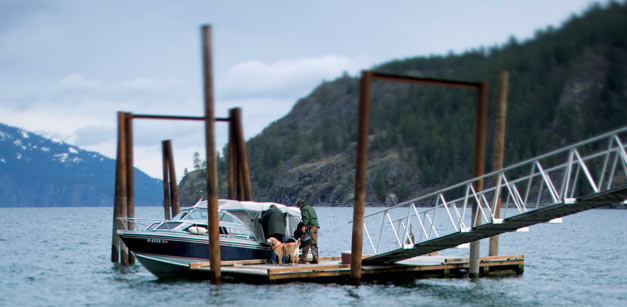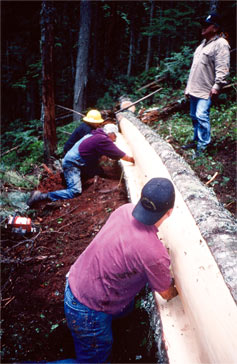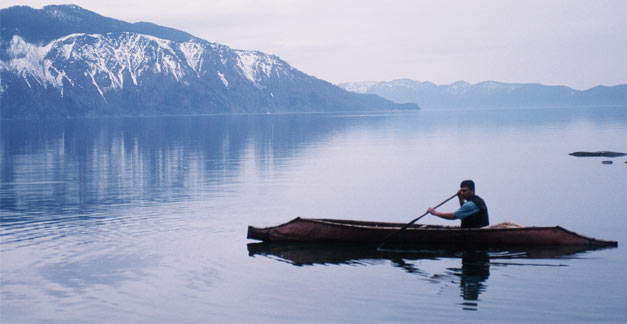| |

|
|
Big water, big book
New book charts Lake Pend Oreille – and its people
“Shimmering beneath the North Idaho summer sun; churning in the fury of a winter storm; brimming with the icy waters of spring runoff; tranquil in the shadowy light of an autumn full moon – Lake Pend Oreille has been the lifeblood of civilizations old and new.”
That’s a passage from the forthcoming book on Lake Pend Oreille by Jane Fritz and numerous contributors.

| Jane Fritz, author of the forthcoming book on Lake Pend Oreille, is an oral historian with a deep connection to the lake. |
|
It’s a guidebook, the first ever devoted to Idaho’s largest lake. At 43 miles long and more than 1,100 feet deep, Lake Pend Oreille dwarfs every other lake in the state, and much of the new book is devoted to describing its physicality and the unique environment and ecology around it. The book provides detailed information for recreational access and activities on the lake, explores its natural and human history and follows the shoreline geography – all 111 miles of it. All that came easy for Fritz, who has had a deep connection to the lake for nearly 30 years as an avid canoeist, swimmer and shoreline wanderer.
But Fritz’s love for the lake gave her other ideas for the book. An oral historian who has produced numerous works for National Public Radio, she was particularly interested in the connections that other people and animals have made to the great lake across the millennia. So she collected their stories, and larded the guidebook with anecdotes, vignettes and even poems about the people and wildlife around the lake.
Following are three selections from Fritz’s new book. The Lake Pend Oreille book is being produced by Keokee Co. – publisher of Sandpoint Magazine – and will reach bookstores later this year. It will also be available online at www.KeokeeBooks.com.
 PHOTO BY WOODS WHEATCROFT PHOTO BY WOODS WHEATCROFT
Riding the mail boat to Kilroy Bay
John Thaxter used to have a desk job. But along with the lure of more time to fish, when opportunity knocked he found himself a storm-worthy vessel and commenced delivering mail for the Bayview post office – by boat. Despite scorching sun, thick winter fog and furious winds that pound the hull of his boat with spectacular waves, Thaxter has delivered mail to the remote outposts of civilization on the east side of Lake Pend Oreille since 1993, six days a week, all year long.
In addition to his contract with the U.S. Postal Service, he also delivers packages for UPS and FedEx. Upon request, he’s also happy to bring a dozen eggs or a loaf of bread from Bayview Mercantile or maybe deliver something a little bigger, like a new washer and dryer. He also offers taxi service.
Deliveries to this side of the lake are much easier to make by boat than by car or truck. The roads through the surrounding mountains, maintained by the U.S. Forest Service, are primarily dirt roads. It takes one and a half hours to drive the 19 miles to Lakeview from Bayview, but by boat it takes only 10 minutes. It can take all day to deliver something to Kilroy Bay (just ask the Sears delivery man who swears he’ll never do it again). But for Thaxter, Kilroy Bay is merely the last stop on his well-traveled lake route; in less than two hours he’s back at the dock at MacDonald’s Hudson Bay Marina and Resort in Bayview after also visiting Lakeview, Cedar Creek, Whiskey Rock, Granite Creek and Pine Cove. The only way to reach these human enclaves once the snow flies is by water because the roads eventually become impassable. So Thaxter is also a lifeline to the residents on this side of the lake during the winter months.
“There’s never a dull moment,” says Thaxter, adding that he really enjoys his work. (But for the record, he actually has less time for fishing.) He particularly likes the challenge of making deliveries on wintry or stormy days, although the near-80 mph winds and 10-foot waves in November 2006 were downright frightening – the worst weather he’s ever seen on the lake.
At each stop along the east shore, most of the residents come down to the docks to meet him and they exchange mailbags and friendly news, and Thaxter always has biscuits for the dogs. Most of the time he doesn’t even have to get out of the boat: “It makes it a little nicer,” he says, “especially when the wind is blowing 30 miles per hour.”
One can imagine the swell of residents who arrive to spend their summers on this isolated side of the lake, but what sort of people lives here year-round? This particular July day, I’m hitching a ride on the mail boat all the way to Kilroy Bay and back to find out.
Argyle Mydland is a former Angus cattle rancher from Montana who, along with three other year-round families, is enjoying his retirement living at Whiskey Rock. He was used to remoteness, but because of the lake’s effect of moderating temperatures, he finds that Whiskey Rock is warmer in winter and cooler in summer than his former home. Mydland really appreciates the old-fashioned hospitality that Thaxter offers to residents like him on Lake Pend Oreille’s east shore, especially during wintertime. “If it wasn’t for John,” he jokingly says, “people here probably wouldn’t get anything to eat!”
“It’s more fun if you do more than what you’re supposed to do,” Thaxter says. Folks like Mydland may be customers, but they’re also friends. “I don’t mind bringing the groceries,” he says. Sometimes Thaxter will even get a phone call in the middle of night. “I make emergency runs, too, sometimes for medications.” Once he helped take a resident to the hospital. After all these years and clocking more than 150,000 miles on the lake, he says he could probably do his route blindfolded. With fuel as expensive as it is – in summer 2007 he was spending $400 a week – he performs the extra duties because he enjoys doing them, not because there’s much money in it.
At Kilroy Bay, there are three year-round residents and 24 families who arrive during summertime. Lou Crisler, a Naval retiree from Spokane, has lived here for 22 years. Since Forest Road No. 278 is several miles away, he usually goes by his own boat across the lake to Garfield Bay when he needs to go to Sandpoint. Lou’s neighbor, Velda McTighe still enjoys living at Kilroy Bay even after her husband, John, died. Surprisingly, no one admits to getting cabin fever here. Instead they spend their days hiking, doing crafts, socializing, watching the storms pass through and viewing wildlife – eagles that flock to Granite Creek for a feast of spawning kokanee in the winter, and moose, deer, elk, mountain goats, and cougar who come to shore year-round. McTighe says some of the ungulates, recalling a cow moose and her calf, will swim across the lake to Garfield Bay. “It’s a little bit of heaven,” says Crisler. “I wouldn’t go anywhere else.”
On the boat heading back to Bayview on this lovely July morning, John Thaxter reveals that although every day on the lake is special, his favorite season of being a mailman on the water is during the winter months when there isn’t a lot of human activity. He says the lake’s monochromatic landscape with ice sculpting the shoreline and wildlife peacefully drinking at the water’s edge is like a beautiful charcoal drawing. Most days he just can’t wait to get out on the water. And as far as jobs go, it’s the best one he’s ever had. |
|
Paddling a Kalispel canoe
The first time I met J.R. Bluff, a Kalispel tribal member, was in 1991 at an environmental education camp for Native American youth held in Clark Fork. We were both camp counselors, but I was the one who had the responsibility of organizing canoe trips to a tribal sacred site in the Clark Fork Delta at Denton Slough.
I called upon several friends with canoes to help. The first evening’s paddle went smoothly, but the next trip was a near disaster. Denton Slough was unusually rough from a storm that had just moved through. It was brisk and windy as June can sometimes be. Suddenly, I realized two girls in a small, peapod-like vessel had capsized halfway across the slough. They had lifejackets on, but they were in very cold water. Not knowing what to do, I sat in my cedar canoe on shore, frozen with panic. J.R. kindly told me to get out of the stern, which I did, and taking my canoe he paddled out to rescue the students. Not only did he save the girls from hypothermia, he taught me a lesson about preparedness when it comes to being responsible for others on the water.
Several years passed before I saw J.R. again, at a Kalispel powwow on his reservation in Usk, Wash. We laughed about how so many years before he had rescued a novice canoeist – on land. Since then we have both grown more proficient in our life’s work: I as an environmental writer and oral historian and he as a tribal leader and now assistant director of the tribe’s culture program. We both have become more adept at canoeing, too. Now he regularly takes tribal youth canoeing on Denton Slough and other places on Lake Pend Oreille as part of his cultural work for the tribe.

| The bark from a white pine tree is stripped to make the canoe. |
|
So it seemed perfect that J.R. Bluff was the first Kalispel in 65 years to paddle a traditional Kalispel canoe again on Lake Pend Oreille. The Kalispel were a canoe people, but with acculturation, a different way of life on the reservation took hold and canoe making became a lost art. A skilled boat builder in the Sandpoint area (who wishes to remain anonymous) had researched their unique, sturgeon-nose design and built a canoe out of traditional, natural materials. It is quite different from other Indian canoes. When Kalispel leaders saw the canoe on display at the Bonner County Historical Society Museum in Sandpoint, where it still is today, they asked the boatwright to help them build another canoe for the tribe.
J.R. and Francis Cullooyah, director of the tribe’s culture program, were both involved in the process of making the second canoe, beginning with stripping the bark from a huge, 50-inch-diameter, live, western white pine tree. The bark had to be removed as a single piece and be longer than 20 feet. Before pioneers logged the hillsides bare around Lake Pend Oreille, Western white pine was the predominant species here, and these trees were giants. In making the Kalispel canoe, the rough outer tree bark becomes the inside of the canoe and the smooth inner bark becomes the outside surface of the boat. The skeletal structure is cedar, and it is lashed together with chokecherry bark. It has a nose of birch bark, and the seams are sealed with pine pitch. It is a very handsome vessel on the water, and as it ages the outer bark surface turns a reddish gold.
J.R. talks about his first paddle in a Kalispel canoe as if he were riding a new horse for the first time. It took a few minutes before he and the canoe got comfortable with each other. “I am a Kalispel,” he remembers saying out loud to his waterborne steed.
He paddled the pine bark canoe out from the Hope Peninsula near Memaloose Island on an April day when snow lingered on the Monarchs before him and geese honked as they flew past low to the water. Sitting on an elk hide in the stern of the canoe, J.R. paddled quietly into open water and thought about his ancestors. He had read once that people in Hope would see Indian canoes out on the water here every morning. He realized that he was rekindling a strong connection to his past. Sitting in the canoe, the teachings of his elders about gratitude came flooding back to him; of how the canoe was at once a simple thing and also at the very heart of his people’s survival.
“Every time I think of Pend Oreille Lake, I think of Indian Meadows and the life of the camp,” J.R. said. “When I’m out there (on the water in a canoe), I’m always visualizing the families that came down and camped – this was a shared area. Even though times were tough and we had to gather meat to make it through the winter, the smiles on the faces of the kids running around, the women working hard, the men out fishing and hunting … we were just a common people following nature, and basically sharing everything with everyone. We need to keep rekindling our connections with the Kalispel places off the reservation.
“Being on the water in a Kalispel canoe was a very special feeling,” J.R. continued. “We were here and are still here today. Everything is still alive. It gives you that extra energy to get back to your regular daily living and say ‘I’m going to do something better.’ There are a lot of people who have paid the price for me to be here, and I have to be sure to keep their memories alive and our heritage and culture strong in the best way I can.” This part of the Kalispel past certainly has been reawakened, as J.R.’s intentions are to carry on the tradition of canoe making as part of the tribe’s culture program. |
|

| J.R. Bluff, a Kalispel Indian, paddles a traditional canoe on Lake Pend Oreille – the first time in 65 years that such a canoe had plied its waters. PHOTOS BY ROBERT C. BETTS/VANGUARD RESEARCH |
|
|
MERGANSERS ON A LOG
During summer quiet, along the lake’s shoreline where the fishing is good, you are apt to find a driftwood log with young, auburn-headed common mergansers – a fish-eating, diving duck – bunched so tightly together that they look like bristles on a brush. It’s hard to count them even with binoculars. Sixteen? No, 17 ... I think. There are also two adult females resting together a little farther up on the log. Are they the mothers of this large brood or babysitters with the birds’ parents out on the lake fishing for food?
The juvenile mergansers’ ivory breasts when facing the golden sun of early morning or late afternoon turn the color of creamery butter tailored into a gray-brown suit of speckled plumage. Then there’s that crest of reddish-brown feathers that sweeps back like a wild head of hair.
Occasionally, when a bird falls off the log or is pushed accidentally by a sibling, the youngster will literally leap out of the water and use its orange feet to snag the log and pull itself back up. Sometimes that sharp, fish-eating beak can help with the process.
A sandpiper, a shorebird with a nest nearby, swoops past the young mergansers scolding the birds. One of the juveniles tries to swipe at the small bird with its sharp beak, missing it. The adult birds are patient with all the activity below them and they say little. But there’s squawking from more than a few of the youngsters on the crowded log as the birds preen one another, stretching and wrapping their long necks around the body of another.
Once the merganser adults have sunned long enough, maybe 15 to 20 minutes, they’ll slip silently back into the water, and the entire brood will immediately follow, jumping down in a series of smooth plops to quietly paddle after them in single-file on their watery march to the next stop.

| The bark from a white pine tree is stripped to make the canoe. Photo by Karen Dingerson |
|
Now it’s easy to count them. Yes, there are 17 juveniles!
Not all of a young merganser’s watery life is so regimented, however. They enjoy playing tag in their nursery area, chasing one another this direction and that, and literally running across the water’s surface like a schoolyard full of children during recess.
Whether they’re fishing, frolicking or playing follow-the-leader, mergansers are a native species of waterfowl in Lake Pend Oreille that are a joy to watch. |
|
|

|
|